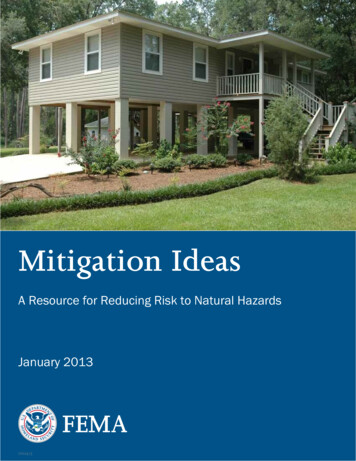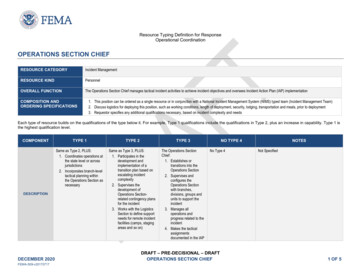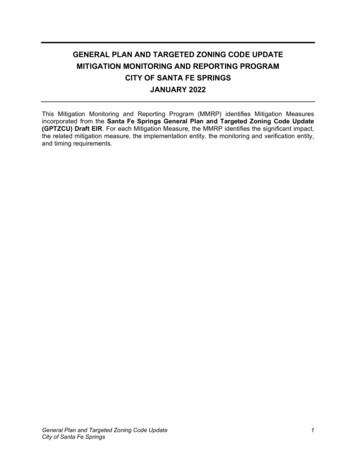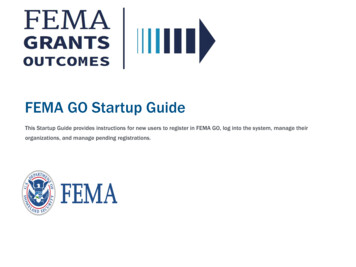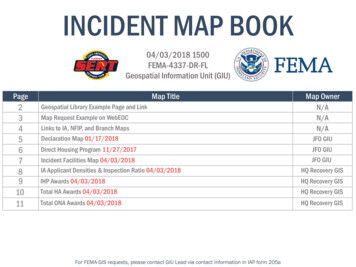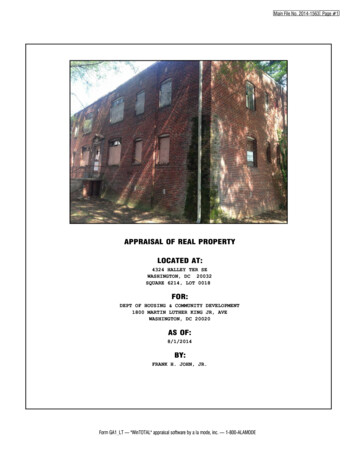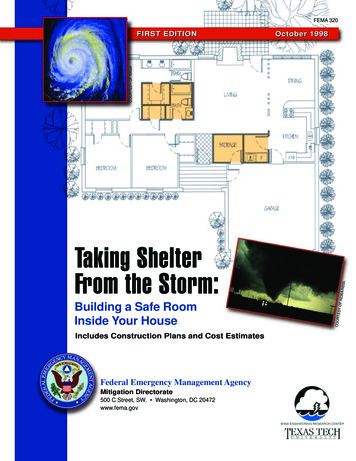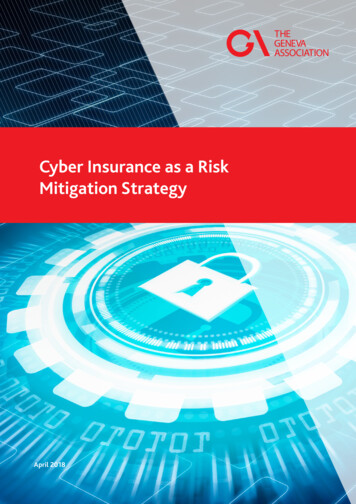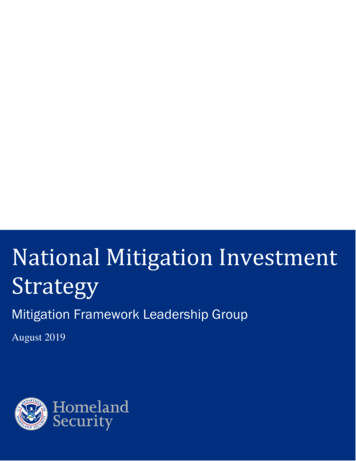
Transcription
National Mitigation InvestmentStrategyMitigation Framework Leadership GroupAugust 20190
About the Mitigation Framework Leadership GroupThe Mitigation Framework Leadership Group (MitFLG) is a national coordinating structureauthorized by the Post-Katrina Emergency Management Reform Act of 2006. The MitFLG wasestablished to organize mitigation efforts across the Federal Government. Composed of federal,state, local, tribal, and territorial public-sector representatives, the MitFLG integrates federalefforts to deliver the mitigation core capabilities in the National Mitigation Framework andassesses the effectiveness of these capabilities across the United States.i
National Mitigation Investment StrategyExecutive SummaryThe National Mitigation Investment Strategy (“NMIS” or Investment Strategy) is a singlenational strategy for advancing mitigation investment to reduce risks posed by natural hazards(for example, sea level rise, droughts, floods, hurricanes, tornados, wildfires, earthquakes) andincreasing the nation’s resilience to natural hazards. The Investment Strategy’s objective is toidentify and measure the effectiveness of mitigation investments, and inform decisions on whenand where to make investments. The Investment Strategy encourages the whole community—including individuals—to invest in mitigation, pre- and post-disaster, by adopting the InvestmentStrategy’s three shared goals. Supporting recommendations focus specifically on how theFederal Government and nonfederal partners can identify, support, influence, and align wholecommunity mitigation investments.The MitFLG will coordinate the Investment Strategy implementation, carried out by the wholecommunity. The MitFLG will periodically evaluate the success of implementation efforts.GOAL 1:Show How Mitigation Investments Reduce RiskThe whole community will build a shared understanding of mitigation investment and its value.Specifically, the whole community will understand how effective mitigation investments canprotect people, homes, neighborhoods, cultural and historic resources, ecosystems, and lifelines1(for example, communications, energy, transportation, and water). The Federal Government andits nonfederal partners will create a shared vocabulary and common measures to communicateinformation about risk and find opportunities to educate, hire, train, and develop a base ofqualified mitigation professionals.GOAL 2:Coordinate Mitigation Investments to Reduce RiskThe whole community will coordinate mitigation investments through shared risk information,reinforced strategies for risk reduction, and easier access to existing funding. Such coordinationwill help the whole community justify mitigation investments and choose the most cost-effectiveand reasonable actions.GOAL 3:Make Mitigation Investment Standard PracticeThe whole community will factor mitigation into investment decisions, especially for buildingsand infrastructure. The Federal Government and its nonfederal partners will use and expandfinancial products and approaches for mitigation investment—including funding, incentives, andfinancial risk transfer opportunities. The Federal Government and its nonfederal partners alsowill make mitigation standard professional practice critical to safeguarding lifelines, services,and national safety and security.1A lifeline enables the continuous operation of critical business and government functions, and it is essential tohuman health and safety or economic security.ii
National Mitigation Investment StrategyTable of ContentsContentsAbout the Mitigation Framework Leadership Group. iExecutive Summary . iiIntroduction . 1The Need for a National Mitigation Investment Strategy . 1Investment Strategy Overview . 3Purpose. 3Audience. . 3Scope. . 3Goals and Recommendations . 5Goal 1: Show How Mitigation Investments Reduce Risk . 5Recommendation 1.1 – Make Mitigation Investment Relevant. 5Recommendation 1.2 – Increase Mitigation Investment by Building the Capacity of Communities toAddress Their Risks . 7Recommendation 1.3 – Use Common Measures to Aid Decision-Making for Mitigation Investment 8Goal 2: Coordinate Mitigation Investments to Reduce Risk . 10Recommendation 2.1 – Make Risk Information More Available and Easier to Use . 10Recommendation 2.2 – Align Program Requirements and Incentives . 10Recommendation 2.3 – Make Funding for Mitigation Investment Easier to Access. 13Goal 3: Make Mitigation Investment Standard Practice . 16Recommendation 3.1 – Encourage Communities to Adopt and Enforce Up-to-Date Building Codes. 16Recommendation 3.2 – Strengthen Critical Infrastructure and Lifelines. 18Recommendation 3.3 – Use and Expand Financial Products and Approaches to Reduce and TransferRisk . 20Next Steps . 21Investment Strategy Implementation Scope . 21Investment Strategy Implementation . 21Conclusion . 22Appendix A: Acronyms and Reference List . 23Appendix B: Glossary of Terms . 25Appendix C: Strategy Development . 26GAO Conditions of Satisfaction Checklist . 26Strategy Development and Stakeholder Engagement . 26iii
National Mitigation Investment StrategyIntroductionThe Need for a National Mitigation Investment StrategyMitigation helps the whole community keep hazards from turning into disasters. In result,mitigation saves lives. Mitigation activities reduce risks to and impacts on lifelines, buildings,infrastructure, ecosystems, and cultural, historic, and natural resources. Mitigation activities alsoimprove resilience. Mitigation includes the capabilities necessary to reduce loss of life andproperty by lessening the impact of disasters (See Scope).In 2018, hurricanes, tornadoes, flooding and landslides due to heavy rains, and wildfires affectedmillions of Americans. Such natural hazards resulted in at least 500 deaths and over 1,300injuries.2 Natural hazards like these are also very expensive. Since 1980, 246 weather-relateddisasters in the United States caused at least 1 billion in damage each. Damage from these“billion-dollar disasters” together totaled over 1.6 trillion.3Mitigation investments include direct investments made to reduce risks posed by hazards tobuildings and infrastructure, for example, buying out structures located in a high-risk area, proneto natural hazards. Investments in mitigation improve safety, security, and economic prosperity.For example, society on average saves 6 for every 1 spent4 through federally fundedmitigation grants, according to the National Institute of Building Science (NIBS).5The Investment Strategy establishes a vision to save lives and money nationwide by investing inmitigation resources and activities, such as: Building and updating structures to the latest codes and standards (for example, buildingand updating infrastructure to withstand severe storms), Collecting and sharing data that identifies risk posed by natural hazards (for example,updated flood maps), Aligning funding requirements and incentives for mitigation investment (for example,mitigation grants and loans),2National Weather Service, Summary of Natural Hazard Statistics for 2018 in the United States (April 25, df.3“Billion Dollar Weather and Climate Disasters: Overview,” National Oceanic & Atmospheric Administration(NOAA) National Centers for Environmental Information (July 9, 2018), https://www.ncdc.noaa.gov/billions/. Thisfigure does not include the billions of dollars of additional damage caused by less costly weather events.4The discount rate used in the 2017 interim Mitigation Saves report is 2.2%. It is not the same 7% discount raterequired by OMB Circular A-94, which would result in a benefit-cost ratio of 4:1. NIBS used the 2.2% discount ratein both studies, partly because it would provide a useful comparison between studies, and partly because the studyteam felt that it was a more appropriate rate for the type of analyses. While the 2.2% discount rate was used toproduce the main benefit-cost ratios for the study, the team also recognized the desire for results using the discountrates required by OMB Circular A-94 (3% and 7%). To that end, all categories of results can be found in a tablewithin the study on page 60 which shows all sub‑categories of BCRs at the 2.2%, 3% and 7% discount rates.5NIBS, Natural Hazard Mitigation Saves: 2017 Interim Report (December 2017, 59-9f866330bd6a1a93f54cdc61088f310a/MS2 2017InterimReport.pdf.1
National Mitigation Investment StrategyFigure 1. Examples of Whole Community Roles in MitigationThe Investment Strategy responds to a recommendation by the U.S. Government AccountabilityOffice (GAO). In 2015, the GAO reviewed the federal response to Hurricane Sandy. Within itskey findings, the GAO found that mitigation investments had not been coordinated, even withinthe Federal Government. This lack of coordination reduced the effectiveness of investments.The Investment Strategy complements other Federal Government initiatives for mitigationinvestment6 and calls for the Federal Government and nonfederal partners to work together.Partners would identify, prioritize, and implement mitigation investments and would developproposed recommendations for future investment in mitigation priorities.7For example, the President’s National Security Strategy establishes four priority actions to promote Americanresilience: (1) improve risk management, (2) build a culture of preparedness, (3) improve planning, and (4)incentivize information sharing. National Security Strategy of the United States of the America (December 2017), at14, /12/NSS-Final-12-18-2017-0905.pdf. Therecommendations within the National Mitigation Investment Strategy complement these priority actions.7See GAO, Report to Congressional Requestors: Hurricane Sandy An Investment Strategy Could Help theFederal Government Enhance National Resilience for Future Disasters, No. GAO 15 515 (July 2015) (GAOHurricane Sandy Report), https://gao.gov/assets/680/671796.pdf.62
National Mitigation Investment StrategyInvestment Strategy OverviewPurpose. The Investment Strategy’s purpose is to increase the nation’s resilience to naturalhazards through more effective, efficient mitigation investment.The Investment Strategy’s goals are to:(1) Show how mitigation investments reduce risk.(2) Coordinate mitigation investments to reduce risk.(3) Make mitigation investment standard practice.See Appendix C for more information on the Investment Strategy’s development.Audience. The Investment Strategy’s national vision is for the whole community.Recommendations on how to identify, support, influence, and align mitigation investments arefor the Federal Government and nonfederal partners. Nonfederal partners address a wide range ofstakeholders within the Investment Strategy. Initiatives will directly address each uniquenonfederal partner stakeholder category during Investment Strategy implementation.Additionally, implementation initiatives will consider the role of individuals and mitigation.Audience DefinitionsThe Federal Government includes all federal departments and agencies in the United States.Nonfederal partners include state, local, tribal, and territorial (SLTT) governments andnonfederal organizations: businesses and industries, academic institutions, faith-basedorganizations, non-governmental organizations, social service and healthcare organizations, andnon-profit organizations.Individuals include every person in the United States.The whole community includes the Federal Government, nonfederal partners, and individuals.Scope. Currently, the Investment Strategy focuses on recommendations to mitigate risks posedby natural hazards (for example, sea level rise, droughts, floods, hurricanes, tornadoes, wildfires,and earthquakes). However, recommendations do not exclude implementation efforts that willalso mitigate risks posed by man-made hazards.The Investment Strategy does not propose structural changes to existing federal programs, newfederal requirements, or new federal legislation. Implementation actions may addressopportunities for improvement to existing programs, however, the Investment Strategy shall notimpair or otherwise affect the authority or responsibility granted by law to an executivedepartment, agency, or the head thereof; nor does it create any right or benefit, substantive orprocedural, enforceable at law or in equity by an party against the United States, its departments,3
National Mitigation Investment Strategyagencies, or entities, its officers, employees, or agents, or any other persons. Changes outside ofthis current scope may be considered later. (See Next Steps.)Recommendations support mitigation investment decision-making that involves: The whole community. All goals and recommendations require collaboration andcommitment by the Federal Government, nonfederal partners, and individuals. Regional and community planning. The whole community should consider regionaland community planning for mitigation activities. This includes public and privateplanning efforts for land use, the environment, infrastructure, transportation, siteplanning, and urban design. Nature-based solutions8 and natural assets. The whole community should considernature-based solutions, such as green infrastructure9, for cost-effectively managing theimpacts of natural hazards. These solutions may provide additional environmental, social,and economic benefits.10 The whole community should also consider protecting naturalassets that help with mitigation (for example, wetlands that reduce the impact of waveson coastal land). Linking risk reduction and financial risk transfer. The whole community shouldbetter link risk reduction and financial risk transfer mechanisms for natural hazard-relatedrisks. For example, flood and other forms of hazard insurance accelerate recoverytimeframes to reduce loss by transferring financial risks from disasters.11 Additionally,insurance providers can increase incentives for policy holders to physically reduce apolicy holder’s risks, and reduce overall damages, suffering, and costs from a disaster. Changing conditions. Population growth, development, and changing weatherconditions will influence mitigation needs and priorities. Vulnerable populations. The whole community should ensure vulnerable populationsare represented during implementation of Investment Strategy recommendations.8Nature-based solutions are sustainable management approaches and practices that use nature and natural systemssuch as wetlands, vegetated areas, forests, urban trees, green roofs and raingardens to address socio-environmentalchallenges. Green infrastructure, ecological engineering, ecosystem mitigation and adaptation and integrated waterresources management are examples of nature-based solutions.9U.S. Environmental Protection Agency website. 2019. What is Green Infrastructure? -infrastructure10Naumann, Sandra; Timo Kaphengst; Keighley McFarland and Jutta Stadler. 2014. Nature-based approaches forclimate change mitigation and adaptation. The challenges of climate change - partnering with nature. GermanFederal Agency for Nature Conservation (BfN), Ecologic Institute, Bonn. https://www.ecologic.eu/1124011CNA Financial Corporation. 2016. Risk Transfer: A Strategy to Help Protect Your bf0-b432-4e0c-97face8730b329d5/RC Guide RiskTransferStrategytoHelpProtectYou Business CNA.pdf?MOD AJPERES4
National Mitigation Investment StrategyWorking Together on Wildfire MitigationHeavy forests put areas around Mount Adams, Washington, at risk of catastrophic wildfires.Mitigating the risk caused by timber (fuel for forest fires) requires extensive cooperation andplanning.Federal land managers at the Wildlife Refuge, community forest managers from the MountAdams Resource Stewards Collaboration, landowners, and National Forests and NationalParks personnel have been working together to treat timber and induce controlled fires. Themulti-year effort spans over nearly 400 acres.These mitigation projects are also supplying wood products, increasing local jobs, enhancingforest health and wildlife habitat, and making nearby communities safer from wildfires.Coordinated timber harvests and controlled fires from 2014 through 2017: Reduced the risk for catastrophic wildfires and their potential for causing loss of livesand extensive damage; Brought in over 3 million in gross receipts and contracts; Created approximately 68 months of full-time equivalent positions; Paid 26,000 in timber excise taxes; and Contributed to roughly 8 million in economic expansion.12Goals and RecommendationsGoal 1: Show How Mitigation Investments Reduce RiskGoal 1 encourages a common understanding of how mitigation investments reduce risks topeople, homes, neighborhoods, cultural and historic resources, ecosystems, and lifelines (forexample, communications, energy, transportation, and water). To achieve this goal, the wholecommunity should use a shared vocabulary to communicate risks and show how mitigationreduces these risks. The Federal Government and nonfederal partners should use education,training, and professional development to increase mitigation investment and build a growingbase of qualified mitigation-informed practitioners.Recommendation 1.1 – Make Mitigation Investment RelevantOver the past several decades, mitigation investments have saved lives and reduced damage toproperty, buildings, and infrastructure. Yet despite strong evidence, not everyone sees the valueof mitigation investment. The whole community—including people with access and functionalneeds—should establish a fundamental understanding of the wide-ranging benefits of mitigation.12Information provided by U.S. Fish and Wildlife: Frank Conner, Prescribed Fire Specialist and Josh O'Connor,Regional Fire Management Coordinator (Pacific Northwest Region).5
National Mitigation Investment StrategyEncourage investment by connecting mitigation to specific priorities. Mitigation investmentinvolves business owners, community officials, homeowners, and others. Many are motivated byemotions and personal, family, or cultural values rather than financial or engineering data. TheFederal Government and nonfederal partners should communicate the value of mitigationthrough using information people can relate to in a personal way.Emphasize the benefits of investment. The Federal Government and nonfederal partners shoulduse specific, personal examples of mitigation investments. They should talk about economic,social, and environmental benefits. For example, mitigation investment: Reduce the risk of injury and loss of life; Makes homes and neighborhoods safer; Strengthens lifelines (for example, energy; food, water, and shelter; health and medical;safety and security; communications; transportation; and hazardous materials); Protects jobs and personal finances; Provides economic benefits; Reduces suffering after a disaster; and Lessens damage to local parks, recreational facilities, and other cultural resources.Link local risks to mitigation opportunities. Linking local risks to mitigation opportunitieshelps the whole community see connections and encourages mitigation investment. For example,as a mitigation opportunity, the local government could encourage small businesses in acommunity prone to flooding to use landscaping elements that slow, collect, infiltrate, and filterrunoff water.Use a common vocabulary. Words related to mitigation investment are often technical andunfamiliar to people outside of certain professions (for example, emergency management,engineering, floodplain management, and insurance). The Federal Government and nonfederalpartners should use language everyone can understand.A shared vocabulary increases the whole community’s understanding of mitigation methods andgoals. The Federal Government and nonfederal partners should identify straightforwarddefinitions for risk, mitigation, and resilience. Additionally, the Federal Government andnonfederal partners can write materials for people who are not frequently exposed to regulatoryand technical guidance.6
National Mitigation Investment StrategyProtecting What MattersLocal leadership can highlight mitigation strategies that protect specific areas most relevant tocommunities, such as historic and cultural districts and landmarks. This recently occurred in thecoastal city of Annapolis, Maryland, an area subject to flooding, hurricanes, tornadoes,thunderstorms, and high wind events.Many of the buildings and monuments in Annapolis are important to our nation’s history and arethe lifeblood of the tourism industry in the area. However, in recent years, Annapolis has beensubject to increased flooding and damage from storms. Due to sea level rise, the potential forsignificant flooding due to a hurricane or tropical storm is forecasted to increase with time,threatening historic, downtown buildings.Annapolis’ Office of Historic Preservation received a 10,000 grant from the National League ofCities’ Leadership in Community Resilience Program. With this grant, the city worked closelywith the community on a Cultural Resource Hazard Mitigation Plan to address the goal ofmitigating damage from rising sea levels, especially damage to cultural resources subject toflooding. The plan ties mitigation investment to community values and helps Annapolis residentsand city leaders identify specific actions to adapt to rising water.Recommendation 1.2 – Increase Mitigation Investment by Building the Capacity ofCommunities to Address Their RisksCommunities need to be able to make informed decisions about risk and mitigation investment.This requires education and training, professional networks committed to mitigation, and a poolof skilled professionals.Improve access to education and training. A variety of education and training materials andresources already exist. However, they can be difficult to find and use.The Federal Government and nonfederal partners should create a more accessible inventory ofavailable resources for mitigation-related training and education. There should be resources forpeople who work outside of the Federal Government. These resources should include “train-thetrainer” materials to expand reach and impact. The Federal Government should work withnonfederal partners to make sure resources for the whole community reflect emerging needs andchanging demands.Create professional networks committed to mitigation. Professional networks encouragecollaboration and information-sharing across government and sectors. Professional networks alsoconnect academics, policymakers, and professionals in common goals and strategies.Professional networks give organizations with different interests a way to talk about sharedconcerns and find opportunities to work together.Develop a pool of skilled mitigation professionals. The Federal Government and nonfederalpartners need to work together to develop, train, and hire the next generation of mitigationprofessionals. To make informed mitigation investments, communities, businesses, andhomeowners need people who know how to organize resources, assess and raise awareness of7
National Mitigation Investment Strategyrisks, and find solutions. Because of the interdisciplinary nature of mitigation, developing thispool of skilled mitigation professionals requires building mitigation into many professions (forexample, planning, engineering/architecture, economics, and communications professions).Building Resilience Through Sharing Information100 Resilient Cities was created by the Rockefeller Foundation and ran from 2013 to 2019. Theprivate organization helped cities around the world deal with the physical, social, and economicchallenges of daily stresses and shocks, such as natural hazards. Increased resilience elevates thewhole community’s threshold if a natural hazard leads to a disaster. (See Recommendation 2.1)Participants joined a global network of member cities. They received expert guidance forestablishing a “Chief Resilience Officer” and developing a robust resilience strategy. Participantswere also connected to service providers, partners, and solutions for putting their resiliencestrategies to work.13Recommendation 1.3 – Use Common Measures to Aid Decision-Making forMitigation InvestmentCommunities want information to help identify the most cost-effective way to improve resilienceto natural hazards, and to create an understanding of how to make the best use of funding formitigation projects. Common measures help answer these and many other questions. Commonmeasures include the metrics, indices, and other tools behind risk ratings for infrastructure andbuildings, community bond ratings, and more. Common measures help organizations compareopportunities, justify investments, and measure success.In mitigation, there are measures that help define and quantify how mitigation improvesresilience. Mitigation criteria and performance measurement tools help determine if and to whatextent mitigation efforts succeed. By developing and applying these criteria and tools,communities may enhance quality of life, overall health, and public safety.Commonly accepted mitigation metrics will help project managers, policy makers, and electedofficials make decisions for mitigation projects (See Recommendation 2.1).14 However, theFederal Government and nonfederal partners do not always consistently share or use mitigationmeasures.15 To improve this situation, the Federal Government and nonfederal partners can:Pilot new tools and refine existing ones. To demonstrate the value of carrying out mitigationprojects, the Federal Government and nonfederal partners should pilot new common measuresand tools and refine existing ones.13Rockefeller Foundation. 100 Resilient Cities website (2019), http://www.100resilientcities.org/.14Common measures and metrics should consider existing, evolving research, and the whole community shouldrecognize that common measures are subject to change over time.15FEMA. Community Resilience Indicators and National Level Measures (2019),https://www.fema.gov/community resilience indicators.8
National Mitigation Investment StrategyEnergyStar and WaterSense are examples of common non-mitigation measures that indicatevalue to the consumer. They are certifications used in the commercial sector to identify productsthat conserve resources and save money without sacrificing functionality. These certificationsprovide users with a common measurement methodology to compare products.16 Likewise, theFederal Government and nonfederal partners should develop commonly accepted measures andtools that show the value of mitigation in a user-friendly way. These common measures will helpproject managers, policy makers, and elected officials during decision-making for mitigationprojects (See Recommendation 2.1).Leverage public-private partnerships. When identifying and developing common measures,
financial products and approaches for mitigation investment—including funding, incentives, and financial risk transfer opportunities. The Federal Government and its nonfederal partners also will make mitigation standard professional practice critical to safeguarding lifelines, services, and national safety and security.
